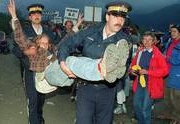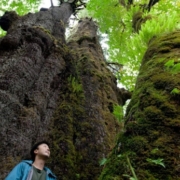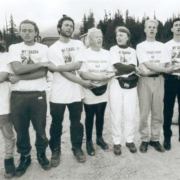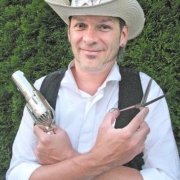It is the quiet amid the chaos just as the logging trucks and police rolled in that Tzeporah Berman remembers acutely about the War in the Woods, the fight by environmentalists 20 years ago over Clayoquot Sound that the now-seasoned campaigner says set the stage for today's battles over pipelines and other resource development issues.
“All of the laughing and the talking and the drumming and whatever was happening would just end,” said Berman.
“There'd be complete silence as all of these people of different ages and different backgrounds stood in front of those trucks, and one by one were taken away.”
Every day for almost three months during the summer of 1993, Berman and hundreds of other protesters stared down the logging trucks destined for some of Canada's most pristine old-growth forests on Vancouver Island, B.C.
She and Valerie Langer helped organize one of the largest acts of civil disobedience in Canadian history in the almost 350,000 hectare wilderness area.
Despite more than 800 arrests, including the iconic mass arrests of more than 300 people on Aug. 9, 1993, the protesters prevented the rainforest from being clear-cut, and sparked a new kind of environmental campaigning.
“For the first time in 20 years, I see the kind of energy that I felt back then,” said Langer in an interview. “I think it's really time for provincial and federal governments to wake up and see that that kind of tension within the population is rising again.”
Environmentalists celebrated the anniversary this weekend, but the mayor of one of the communities hardest hit by the eventual decision to reverse clear-cut logging in the sound and preserve it as a UNESCO biosphere, says his community has little to cheer.
“It had several layers of impact, bearing in mind there's been forestry companies in Ucluelet since the turn of the century,” said Ucluelet Mayor Bill Irving.
“Those folks were sort of lifetime residents and employees in the forest industry, and they did it because they enjoyed it.”
He said the events of the so-called War in the Woods were “quite a significant rebuff to them both as individuals and as members of the economy.”
“You carry sort of a jaded sense of fair play of that experience on into your future years,” said Irving, who worked for 20 years in forestry himself and said the suggested riches of transitioning from an economy based on forestry and fishery to one based on tourism have never really panned out.
The protests began after the provincial NDP government decided to allow forest products company MacMillan Bloedel — then a scion of B.C. business but no longer in existence — to clear cut in the old-growth forest about 200 kilometres northwest of Victoria.
Environmentalists said the trees were some of the oldest and largest in Canada.
Starting in July 1993, the protest crowds grew and grew and so did the coverage, reaching around the globe as environmentalists demonstrated outside Canadian embassies and high commissions in England, Australia, Germany, Austria, the United States and Japan.
Australian rock group Midnight Oil played a concert at the protesters' camp, with lead singer Peter Garrett declaring: “This is no way to look after the land.”
Environmental lawyer Robert Kennedy Jr. upped the star power when he criticized MacMillan Bloedel for destroying the wilderness and suggested aboriginal people should be given control of forest resources.
The protests reached a peak Aug. 9, 1993, when hundreds of men, women and children clogged a logging road bridge leading to the site.
Despite being read a court injunction intended to ensure MacBlo, as it was known, could continue its work, the protesters refused to move.
Police reinforcements were called in. Still the protesters refused to move.
Police had to physically carry away the limp demonstrators, straining backs along with resources. A school bus was used to transport the arrested to an athletic centre into Ucluelet, where the single holding cell was in no way appropriate for all those arrested.
The process took all day, said Langer.
“It was an act of courage. Every day, for three months, ordinary people came and said 'I do not want the forest of this area or any other area destroyed.”'
By the time the protest camp was dismantled that October, more than 800 people had been arrested. They included then-NDP MP Svend Robinson, who was given a 14-day sentence for criminal contempt of court. Greenpeace appealed the fines and house arrest sentences to the Supreme Court of Canada, but in 1996, the high court rejected its efforts.
Berman herself faced six years in prison, charged with 857 counts of criminally aiding and abetting the protesters. All the charges were dismissed on constitutional grounds years later.
Langer, who trained as a linguist, said for years prior to 1993, environmentalists had been trying to affect change in the way B.C.'s forests were harvested, with little impact. But the tactic of trying to hit forestry companies through their customers, of seeking out and winning international attention and the War in the Woods' successful use of civil disobedience became a model for environmentalists around the world.
Berman, who now has a national profile campaigning on conservation issues, said Clayoquot's reverberations are being felt acutely now. She noted a protest last October in which thousands turned up on the legislature lawn in Victoria to protest against the proposed Enbridge Northern Gateway pipeline and the expansion of Kinder Morgan's TransMountain pipeline.
“What was fascinating is I kept meeting so many of the same people,” she said. “So many people came up and said 'I was there in '93 and I'm here now. I won't let this pipeline go through.”'
The Clayoquot protesters went home before winter in 1993, but the wrangle over protecting the sound continued.
In 1996, the provincial government covered the extra costs for MacMillan Bloedel to log the territory in an ecologically sound way in a three-year a $9.3 million deal.
In 2000, the area was designated a UNESCO biosphere reserve, meaning it is recognized as an area that balances conservation and economic development. Iisaak Forest Resources Ltd., a joint venture between the Nuu-Chah-nulth First Nations and Weyerhaeuser, which bought MacMillan Bloedel, was formed to conduct small-scale logging in the area. It had the support of several environmental groups, including Greenpeace.
But Mayor Irving said while the resolution to the Clayoquot controversy held promise, that wasn't met for his community.
“Rather than being a world-class example of forestry, eco-system management and building up a significant knowledge base of the interaction of the economy and the environment, there has been almost nothing,” he said.
After the protests, Irving said representatives from the environment, forest industry, First Nations and all three levels of government came together to discuss how to manage the area in a ground-breaking way.
But Irving said there's now nothing left of that process.
“No opportunity was taken of the great expense that was put into the planning of this area.”
As Canada's economy becomes more firmly linked to its resources, George Hoberg, a professor at the University of British Columbia who specializes in forestry and sustainable energy policy, said the impact of Clayoquot Sound protests can't be ignored.
“They were a watershed moment in environmental politics in British Columbia, and they had a enduring impact on the forest industry, but also broader impacts on other resource industries,” he said.
“The conflicts over pipelines now have in some way been inspired by Clayoquot Sound, and if there's ever a time when one of the two big pipeline proposals in BC … get approved, I think you'll see a civil disobedience campaign that will dwarf the one that occurred in Clayoquot Sound.”
Read more: https://bc.ctvnews.ca/war-in-the-woods-mass-arrests-20-years-ago-prompted-lasting-change-1.1406602









